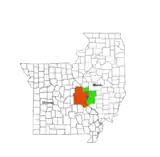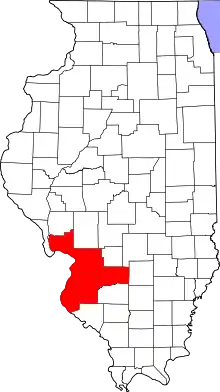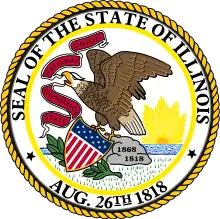St. Clair County, Illinois
St. Clair County is the oldest county in the U.S. state of Illinois; its western border is formed by the Mississippi River, bordering the U.S. state of Missouri. It is a part of the Metro East in southern Illinois. According to the 2010 United States Census, it had a population of 270,056,[1] making it the eighth-most populous county in Illinois and the most populous in the southern portion of the state. Its county seat is Belleville.[2] The county was founded in 1790 by the government of the Northwest Territory, before the establishment of Illinois as a state. Cahokia Village in the county was founded in 1697 and was a French settlement and former Jesuit mission.
St. Clair County | |
|---|---|
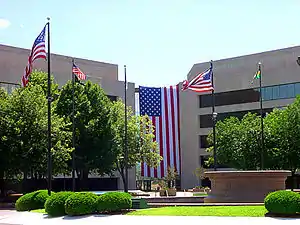 St. Clair County Courthouse, Belleville | |
 Flag | |
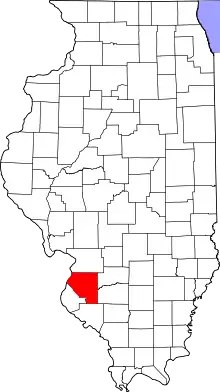 Location within the U.S. state of Illinois | |
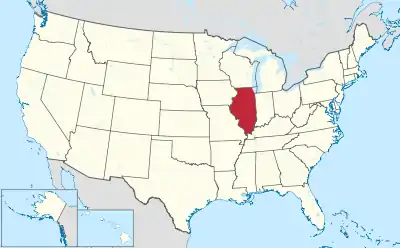 Illinois's location within the U.S. | |
| Coordinates: 38°28′N 89°56′W | |
| Country | |
| State | |
| Founded | 1790 |
| Named for | Arthur St. Clair |
| Seat | Belleville |
| Largest city | Belleville |
| Area | |
| • Total | 674 sq mi (1,750 km2) |
| • Land | 658 sq mi (1,700 km2) |
| • Water | 16 sq mi (40 km2) 2.4% |
| Population (2010) | |
| • Total | 270,056 |
| • Estimate (2019) | 259,686 |
| • Density | 400/sq mi (150/km2) |
| Time zone | UTC−6 (Central) |
| • Summer (DST) | UTC−5 (CDT) |
| Congressional district | 12th |
| Website | www |


St. Clair County is part of the American Bottom or Metro-East area of the St. Louis, MO-IL Metropolitan Statistical Area.
In 1970, the United States Census Bureau placed the mean center of U.S. population in St. Clair County.[3]
History
This area was occupied for thousands of years by cultures of indigenous peoples. The first modern explorers and colonists of the area were French and French Canadians, founding a mission settlement in 1697 now known as Cahokia Village. After Great Britain defeated France in the Seven Years' War in 1763 and absorbed its territory in North America east of the Mississippi River, British-American colonists began to move into the area. Many ethnic and Catholic French moved to settlements west of the river rather than live under British Protestant rule.
After the United States achieved independence in the late 18th century, St. Clair County was the first county established in present-day Illinois; it antedates Illinois' existence as a separate jurisdiction. The county was established in 1790 by a proclamation of Arthur St. Clair, first governor of the Northwest Territory, who named it after himself.
The original boundary of St. Clair county covered a large area between the Mackinaw and Ohio rivers. In 1801, Governor William Henry Harrison re-established St. Clair County as part of the Indiana Territory, extending its northern border to Lake Superior and the international border with Rupert's Land.[4]
When the Illinois Territory was created in 1809, Territorial Secretary Nathaniel Pope, in his capacity as acting governor, issued a proclamation establishing St. Clair and Randolph County as the two original counties of Illinois.
 St. Clair County as it was re-established in 1809. This diagonal border line had been drawn by the Indiana Territorial government in 1803.[4]
St. Clair County as it was re-established in 1809. This diagonal border line had been drawn by the Indiana Territorial government in 1803.[4] St. Clair County between 1812 and 1813
St. Clair County between 1812 and 1813 St. Clair County between 1813 and 1816
St. Clair County between 1813 and 1816 St. Clair County between 1816 and 1818
St. Clair County between 1816 and 1818 St. Clair County between 1818 and 1825
St. Clair County between 1818 and 1825 St. Clair County between 1825 and 1827
St. Clair County between 1825 and 1827 St. Clair County from 1827 to present
St. Clair County from 1827 to present
Originally developed for agriculture, this area became industrialized and urbanized in the area of East St. Louis, Illinois, a city that developed on the east side of the Mississippi River from St. Louis, Missouri. It was always strongly influenced by actions of businessmen from St. Louis, who were initially French Creole fur traders with western trading networks.
In the 19th century, industrialists from St. Louis put coal plants and other heavy industry on the east side of the river, developing East St. Louis. Coal from southern mines was transported on the river to East St. Louis, then fed by barge to St. Louis furnaces as needed. After bridges spanned the river, industry expanded.
In the late 19th and early 20th centuries, the cities attracted immigrants from southern and eastern Europe and from the South. In 1910 there were 6,000 African Americans in the city. With the Great Migration underway from the rural South, to leave behind Jim Crow and disenfranchisement, by 1917, the African-American population in East St. Louis had doubled. Whites were generally hired first and given higher–paying jobs, but there were still opportunities for American blacks. If hired as strikebreakers, they were resented by white workers, and both groups competed for jobs and limited housing in East St. Louis. The city had not been able to keep up with the rapid growth of population. The United States was developing war industries to support its eventual entry into the Great War, now known as World War I.
In February 1917 tensions in the city arose as white workers struck at the Aluminum Ore Company. Employers fiercely resisted union organizing, sometimes with violence. In this case they hired hundreds of blacks as strikebreakers. White workers complained to the city council about this practice in late May. Rumors circulated about an armed African American man robbing a white man, and whites began to attack blacks on the street. The governor ordered in the National Guard and peace seemed restored by early June.
"On July 1, a white man in a Ford shot into black homes. Armed African-Americans gathered in the area and shot into another oncoming Ford, killing two men who turned out to be police officers investigating the shooting."[5] Word spread and whites gathered at the Labor Temple; the next day they fanned out across the city, armed with guns, clubs, anything they could use against the blacks they encountered. From July 1 through July 3, 1917, the East St. Louis riots engulfed the city, with whites attacking blacks throughout the city, pulling them from streetcars, shooting and hanging them, burning their houses. During this period, some African Americans tried to swim or use boats to get to safety; thousands crossed the Eads Bridge to St. Louis, seeking refuge, until the police closed it off. The official death toll was 39 blacks and nine whites, but some historians believe more blacks were killed.[5] Because the riots were racial terrorism, the Equal Justice Initiative has included these deaths among the lynchings of African Americans in the state of Illinois in its 2017 3rd edition of its report, Lynching in America.[6]
The riots had disrupted East St. Louis, which had seemed to be on the rise as a flourishing industrial city. In addition to the human toll, they cost approximately $400,000 in property damage[7] (over $8 million, in 2017 US Dollars [8]). They have been described as among the worst labor and race-related riots in United States history, and they devastated the African-American community.
Rebuilding was difficult as workers were being drafted to fight in World War I. When the veterans returned, they struggled to find jobs and re-enter the economy, which had to shift down to peacetime.
In the late 20th century, national restructuring of heavy industry cost many jobs, hollowing out the city, which had a marked decline in population. Residents who did not leave have suffered high rates of poverty and crime. In the early 21st century, East St. Louis is a site of urban decay. Swathes of deteriorated housing were demolished and parts of the city have become urban prairie. In 2017 the city marked the centennial of the riots that had so affected its residents.
Other cities in St. Clair County border agricultural or vacant lands. Unlike the suburbs on the Missouri side of the metro area, those in Metro-East are typically separated by agriculture, or otherwise undeveloped land left after the decline of industry. The central portion of St. Clair county is located on a bluff along the Mississippi River. This area is being developed with suburban housing, particularly in Belleville, and its satellite cities. The eastern and southern portion of the county is sparsely populated. The older small communities and small tracts of newer suburban villages are located between large areas of land devoted to corn and soybean fields, the major commodity crops of the area.
Geography
According to the US Census Bureau, the county has a total area of 674 square miles (1,750 km2), of which 658 square miles (1,700 km2) is land and 16 square miles (41 km2) (2.4%) is water.[9]
Climate and weather
| Belleville, Illinois | ||||||||||||||||||||||||||||||||||||||||||||||||||||||||||||
|---|---|---|---|---|---|---|---|---|---|---|---|---|---|---|---|---|---|---|---|---|---|---|---|---|---|---|---|---|---|---|---|---|---|---|---|---|---|---|---|---|---|---|---|---|---|---|---|---|---|---|---|---|---|---|---|---|---|---|---|---|
| Climate chart (explanation) | ||||||||||||||||||||||||||||||||||||||||||||||||||||||||||||
| ||||||||||||||||||||||||||||||||||||||||||||||||||||||||||||
| ||||||||||||||||||||||||||||||||||||||||||||||||||||||||||||
In recent years, average temperatures in the county seat of Belleville have ranged from a low of 22 °F (−6 °C) in January to a high of 90 °F (32 °C) in July, although a record low of −27 °F (−33 °C) was recorded in January 1977 and a record high of 117 °F (47 °C) at East St. Louis, Illinois was recorded in July 1954.[11][12][13] Average monthly precipitation ranged from 2.02 inches (51 mm) in January to 4.18 inches (106 mm) in May.[10]
Transportation
Major highways
 Interstate 55
Interstate 55 Interstate 64
Interstate 64 Interstate 70
Interstate 70 Interstate 255
Interstate 255 U.S. Highway 40
U.S. Highway 40 U.S. Highway 50
U.S. Highway 50 Illinois Route 3
Illinois Route 3 Illinois Route 4
Illinois Route 4 Illinois Route 13
Illinois Route 13 Illinois Route 15
Illinois Route 15 Illinois Route 111
Illinois Route 111 Illinois Route 156
Illinois Route 156 Illinois Route 157
Illinois Route 157 Illinois Route 158
Illinois Route 158 Illinois Route 159
Illinois Route 159 Illinois Route 161
Illinois Route 161 Illinois Route 163
Illinois Route 163 Illinois Route 177
Illinois Route 177 Illinois Route 203
Illinois Route 203
Public transit
St. Clair County is home to 11 St. Louis MetroLink stations on the Red and Blue Lines.
St. Clair County is also served by Metrobus and Madison County Transit.
Adjacent counties and city
- Madison County (north)
- Clinton County (northeast)
- Washington County (east)
- Randolph County (south)
- Monroe County (southwest)
- St. Louis, Missouri (west)
- St. Louis County, Missouri (west)
Demographics
| Historical population | |||
|---|---|---|---|
| Census | Pop. | %± | |
| 1820 | 5,253 | — | |
| 1830 | 7,078 | 34.7% | |
| 1840 | 13,631 | 92.6% | |
| 1850 | 20,180 | 48.0% | |
| 1860 | 37,694 | 86.8% | |
| 1870 | 51,068 | 35.5% | |
| 1880 | 61,806 | 21.0% | |
| 1890 | 66,571 | 7.7% | |
| 1900 | 86,685 | 30.2% | |
| 1910 | 119,870 | 38.3% | |
| 1920 | 136,520 | 13.9% | |
| 1930 | 157,775 | 15.6% | |
| 1940 | 166,899 | 5.8% | |
| 1950 | 205,995 | 23.4% | |
| 1960 | 262,509 | 27.4% | |
| 1970 | 285,176 | 8.6% | |
| 1980 | 267,531 | −6.2% | |
| 1990 | 262,852 | −1.7% | |
| 2000 | 256,082 | −2.6% | |
| 2010 | 270,056 | 5.5% | |
| 2019 (est.) | 259,686 | [14] | −3.8% |
| US Decennial Census[15] 1790-1960[16] 1900-1990[17] 1990-2000[18] 2010-2019[1] | |||
As of the 2010 United States Census, there were 270,056 people, 105,045 households, and 70,689 families residing in the county.[19] The population density was 410.6 inhabitants per square mile (158.5/km2). There were 116,249 housing units at an average density of 176.7 per square mile (68.2/km2).[9] The racial makeup of the county was 64.6% white, 30.5% black or African American, 1.2% Asian, 0.2% American Indian, 0.1% Pacific islander, 1.2% from other races, and 2.2% from two or more races. Those of Hispanic or Latino origin made up 3.3% of the population. In terms of ancestry, 27.5% were German, 11.1% were Irish, 7.4% were English, and 4.6% were American.[20]
Of the 105,045 households, 34.7% had children under the age of 18 living with them, 44.6% were married couples living together, 17.7% had a female householder with no husband present, 32.7% were non-families, and 27.5% of all households were made up of individuals. The average household size was 2.53 and the average family size was 3.09. The median age was 36.9 years.
The median income for a household in the county was $48,562 and the median income for a family was $61,042. Males had a median income of $47,958 versus $34,774 for females. The per capita income for the county was $24,770. About 12.3% of families and 15.5% of the population were below the poverty line, including 24.7% of those under age 18 and 9.7% of those age 65 or over.[21]
Government and infrastructure
The Southwestern Illinois Correctional Center, operated by the Illinois Department of Corrections, is near East St. Louis.[22]
Also located in St. Clair County is Scott Air Force Base, which is home to U.S. Transportation Command, the Air Force's Air Mobility Command, and the Military Surface Deployment and Distribution Command.
Politics
St. Clair County is a reliably Democratic county, having voted for the Democratic presidential candidate in every presidential election since 1928, with the exception of the 1972 United States presidential election.
| Year | Republican | Democratic | Third parties |
|---|---|---|---|
| 2020 | 44.6% 57,150 | 53.3% 68,325 | 2.0% 2,616 |
| 2016 | 44.4% 53,857 | 50.0% 60,756 | 5.6% 6,823 |
| 2012 | 41.8% 50,125 | 56.2% 67,285 | 2.0% 2,417 |
| 2008 | 38.1% 47,958 | 60.4% 76,160 | 1.5% 1,936 |
| 2004 | 44.4% 50,203 | 55.1% 62,410 | 0.5% 576 |
| 2000 | 42.1% 42,299 | 55.7% 55,961 | 2.1% 2,133 |
| 1996 | 35.0% 33,066 | 56.6% 53,405 | 8.4% 7,958 |
| 1992 | 29.7% 31,951 | 53.6% 57,625 | 16.7% 17,965 |
| 1988 | 42.6% 41,439 | 57.0% 55,465 | 0.4% 409 |
| 1984 | 49.0% 51,046 | 50.2% 52,294 | 0.8% 808 |
| 1980 | 45.8% 46,063 | 49.7% 50,046 | 4.5% 4,564 |
| 1976 | 39.9% 40,333 | 58.6% 59,177 | 1.5% 1,555 |
| 1972 | 51.5% 50,519 | 47.5% 46,636 | 1.0% 942 |
| 1968 | 34.1% 34,442 | 50.3% 50,726 | 15.6% 15,706 |
| 1964 | 27.6% 28,226 | 72.4% 74,005 | 0.0% 0 |
| 1960 | 38.3% 42,046 | 61.4% 67,367 | 0.3% 338 |
| 1956 | 42.8% 41,528 | 56.9% 55,295 | 0.3% 283 |
| 1952 | 39.5% 39,713 | 60.0% 60,311 | 0.5% 479 |
| 1948 | 36.1% 30,883 | 63.4% 54,260 | 0.6% 474 |
| 1944 | 40.8% 33,557 | 58.8% 48,325 | 0.4% 327 |
| 1940 | 40.1% 35,998 | 59.5% 53,482 | 0.5% 411 |
| 1936 | 31.9% 26,684 | 64.8% 54,238 | 3.4% 2,840 |
| 1932 | 31.3% 22,744 | 65.2% 47,305 | 3.5% 2,522 |
| 1928 | 45.6% 31,026 | 53.5% 36,374 | 0.9% 637 |
| 1924 | 45.9% 23,380 | 29.3% 14,921 | 24.9% 12,693 |
| 1920 | 51.3% 21,681 | 33.2% 14,032 | 15.4% 6,518 |
| 1916 | 47.7% 22,134 | 48.8% 22,622 | 3.6% 1,650 |
| 1912 | 31.5% 8,156 | 41.9% 10,826 | 26.6% 6,884 |
| 1908 | 48.7% 12,619 | 43.7% 11,342 | 7.6% 1,973 |
| 1904 | 55.3% 11,926 | 38.0% 8,200 | 6.7% 1,435 |
| 1900 | 48.7% 9,764 | 49.0% 9,827 | 2.4% 472 |
| 1896 | 51.0% 8,960 | 47.5% 8,345 | 1.6% 278 |
| 1892 | 44.7% 6,276 | 51.4% 7,207 | 3.9% 551 |
Communities
Cities
Villages
Census-designated places
Unincorporated communities
- Douglas
- Imbs
- North Dupo
- Pine Lake
- State Park Place
- Westview
References
- "State & County QuickFacts". US Census Bureau. Retrieved July 8, 2014.
- "Find a County". National Association of Counties. Retrieved June 7, 2011.
- "Mean Center of Population for the United States: 1790 to 2000" (PDF). US Census Bureau. Archived from the original (PDF) on November 3, 2001. Retrieved September 17, 2011.
- White, Jesse. Origin and Evolution of Illinois Counties. State of Illinois, March 2010.
- Alison Keyes, "The East St. Louis Race Riot Left Dozens Dead, Devastating a Community on the Rise", Smithsonian Magazine, 30 June 2017; accessed 26 May 2018
- "Lynching in America/Supplement by County, 3rd ed. (2017) p. 4" (PDF). Archived from the original (PDF) on October 23, 2017. Retrieved July 5, 2018.
- "The Negro Silent Protest Parade organized by the NAACP Fifth Ave., New York City July 28, 1917" (PDF). National Humanities Center, Research Triangle Park, NC. National Humanities Center. 2014. Retrieved July 28, 2017.
- "Calculate the value of $400,000 in 1917". www.dollartimes.com.
- "Population, Housing Units, Area, and Density: 2010 - County". US Census Bureau. Archived from the original on February 12, 2020. Retrieved July 12, 2015.
- "Monthly Averages for Belleville IL". The Weather Channel. Retrieved January 27, 2011.
- Westcott, Nancy E. (July 2011). "The Prolonged 1954 Midwestern US Heat Wave: Impacts and Responses". Wea. Climate Soc. 3 (3): 165–76. doi:10.1175/WCAS-D-10-05002.1.
- "Lessons Learned from 1950s' Heat Wave Show Planning Needed for Future Severe Events" (Press release). Illinois State Water Survey. May 18, 2011. Archived from the original on April 15, 2012. Retrieved November 4, 2011.
- Westcott, Nancy (January 19, 2010). "Impacts of the 1954 Heat Wave". 18th Conference on Applied Climatology. Atlanta GA: American Meteorological Society.
- "Population and Housing Unit Estimates". Retrieved March 26, 2020.
- "US Decennial Census". US Census Bureau. Retrieved July 8, 2014.
- "Historical Census Browser". University of Virginia Library. Retrieved July 8, 2014.
- "Population of Counties by Decennial Census: 1900 to 1990". US Census Bureau. Retrieved July 8, 2014.
- "Census 2000 PHC-T-4. Ranking Tables for Counties: 1990 and 2000" (PDF). US Census Bureau. Retrieved July 8, 2014.
- "Profile of General Population and Housing Characteristics: 2010 Demographic Profile Data". US Census Bureau. Archived from the original on February 13, 2020. Retrieved July 12, 2015.
- "Selected Social Characteristics in the United States – 2006-2010 American Community Survey 5-Year Estimates". US Census Bureau. Archived from the original on February 13, 2020. Retrieved July 12, 2015.
- "Selected Economic Characteristics – 2006-2010 American Community Survey 5-Year Estimates". US Census Bureau. Archived from the original on February 13, 2020. Retrieved July 12, 2015.
- Southwestern Illinois Correctional Center. IL Dept of Corrections. Retrieved on July 10, 2010.
- Leip, David. "Atlas of US Presidential Elections". uselectionatlas.org. Retrieved March 27, 2018.
- "Belleville officially takes over township's duties". bnd.com. Retrieved March 27, 2018.
